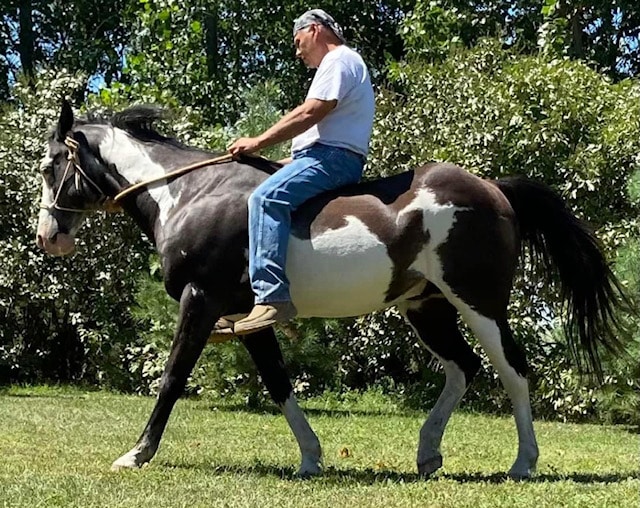Long Feather demonstration on Wi waha chi, also known as Sundance, during Cultural Camp [Photo: Volney Fasthorse]
“We have a long ancestral history in Standing Rock. That history depends a lot on our knowledge of our horse relatives. Our ancestors used horses for teaching, healing, learning, and communication about ourselves. The Lakota and Dakota Sioux tribes have experienced the gift and power of horses throughout life as far back as we can remember,” said Volney Fasthorse.
Standing Rock Indian Reservation, Ft. Yates, North Dakota is home to tribal members that are on a path towards sharing and gathering people from all walks of life. Along with the support of Standing Rock Community Development Corporation and its executive director, Brian Thunderhawk, Volney Fasthorse and Richard Long Feather have united to share how horses and their language support life skills, relationships, healing, and happiness.
“It’s time to share how we use horses and our native language, Lakota and Dakota, to communicate. We came up with this idea to gather people from around the area to demonstrate how this relationship functions,” said Fasthorse.
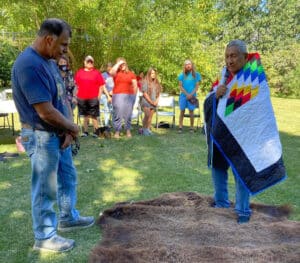
Long Feather honoring Thomas Redbird for preserving the Lakota Language [Photo: Volney Fasthorse]
They hosted a two-day Cultural Camp at the end of July at the Richard and Virginia Long Feather residence outside of Ft. Yates where many gathered and shared stories in the Lakota and Dakota dialects of their language. They demonstrated horsemanship communication in the Lakota language, assembled a traditional tipi with guest help, said prayers, and served traditional dishes.
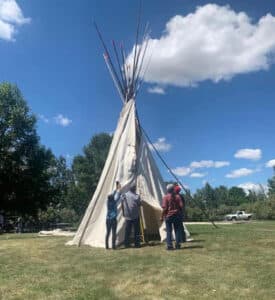
Tipi Assemble [Photo: Volney Fasthorse]
Long Feather and Fasthorse, among many other Standing Rock Sioux tribe members, were put on horseback by their grandparents before they could walk. They rode double and were taught to work with the horse by teaching, communicating, and learning from the animal.
“We learned how to understand what we want them to do, and what we don’t want to do is stress a horse out. We were taught to respect the horse. They teach us respect through being patient. The horse teaches us not to rush things, much like in life. Overall, the horse requires respect and trust to be taught. That is what we transfer over to human relationships,” explained Fasthorse.
Fasthorse’s grandparents and ancestors taught him that we can make good or bad choices. The horse will make the right choice most of the time, and it’s our job as the human to learn and communicate through the right choices to allow the animal to trust you.
“My grandmother would always say, speaking good of people and choosing kind words to come out of our mouths was important. When we are in a negative state of mind and wishing bad upon others by voicing it or thinking it, the horse will pick up on that energy. If a person is carrying around negativity, that’s not self-respect. The horses can sense that,” added Fasthorse.
Richard Long Feather, his wife, Virginia, and their family are long-time veterans to the Indian Relay Races and travel across the nation with their team. The culture of this event continued this past Saturday, August 6 at the Long Soldier Wild Horse Stamped Arena in Ft. Yates.
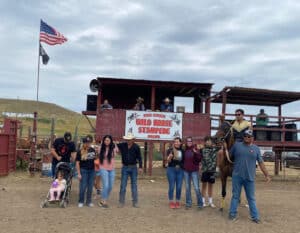
Jace Long Feather, Chief’s Race Champion [Photo: Virginia Long Feather]
Long Feather said that for the one-day race, there was a large and excited audience gathering around the track. There were also a lot of festivities for the youth including foot races, boot scramble, and pony races.
He explained that the Indian Relay races consist of short races which are three-eighths to five-eighths of a mile. The men’s teams require three horses, while the junior relay short races require two horses. The mile, or long races, require two exchanges, which is six horses per team. Four horses and two exchanges for the junior relay.
“The first horse in a relay needs to be the ‘speed horse.’ This is your fastest horse out of the gate. The middle horse needs to be average speed, not too fast or too slow, but able to have rider mount on and off efficiently. Sometimes you have an extra anchor horse to catch if you fall behind,” explained Long Feather.
The Long Feather family’s relay horses are just that — family. They spend their life caring, teaching, and learning how to have the animal perform and trust them as family. During the cultural camp, on-lookers could find Long Feather speaking to his entire herd in Lakota.
During the long winter evenings of North Dakota, one can find Long Feather singing his own Lakota songs to his herd of horses.
“The language and spirit of our cultural brings us a natural ability make songs. I think my horses may kind of fight over the serenading and massaging, but they thoroughly enjoy it,” Long Feather said.
“Horses understand the language we are speaking whether it’s German, English, or Lakota. They are paying attention one hundred percent to the different sounds in any language we speak. Talking to your horse while teaching and riding brings a special gift — a relationship that gives the human patience and humbleness,” added Fasthorse.
Fasthorse and Long Feather said bringing horses and fluent speaking Dakota and Lakota speakers back to the table or the fast track is a common goal of theirs. They are planning more events and gatherings soon. For more information, visit www.standingrockcommunitydevelopmentcorporation.com.
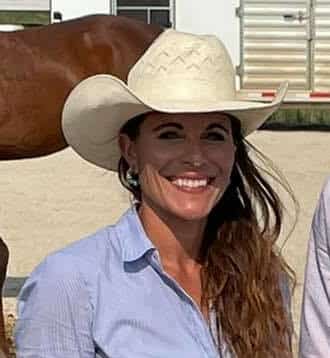
Tisa Peek is a long-time horse trainer, competitor in barrel racing and team roping, and writer about the equine. Rodeo and horses run deep in her roots. JT Family Equine is where she calls home, south of Bismarck, ND. Tisa, along with her husband, Jon, and boys, Blu and River, train horses and host clinics. Tisa is the host for Dakota Cowboy on BEK TV.


